Microsoft BUILD: Windows 8, A Pre-Beta Preview
by Brian Klug & Ryan Smith on September 13, 2011 12:05 PM EST- Posted in
- BUILD
- Windows
- Microsoft
- Windows 8
- Trade Shows
The Technical Side Of Windows 8: Cont
Moving up the chain, Microsoft has added a number of base class drivers for hardware in Windows 8. This includes not only USB 3, but also class drivers for mobile broadband radios, sensors, and even printers. For printers this means Windows 8 can print to roughly 70% of all Windows 7 certified printers without an additional driver, which is nearly a necessity for Windows 8 as an ARM tablet OS, as drivers may not be available and tracking down a driver flies in the face of the modern pre-configured OS model for tablets.
For mobile broadband things are a bit more interesting. With this addition mobile broadband is being promoted to a first class connectivity option, right up there with Wi-Fi and Ethernet. Mobile broadband hardware can then be integrated into a laptop or a tablet or added via a dongle without requiring a driver or a complex dialer/manager application. Managers will still exist in a lesser form as a Metro application; Microsoft included one such example with the tablet we tested, which had a working AT&T 3G modem and its associated management application.

Windows 8 will also be aware of the limitations of mobile broadband connections, with an emphasis in usage caps. Given appropriate information by the ISP Windows 8 knows to halt background download processes (e.g. Windows Update, weather updates, RSS) to keep them from consuming valuable bits, and to notify the user if the device is approaching the cap and would be subject to overages. Along these lines Windows 8 also knows to switch to another source (i.e. Wi-Fi) when it’s available to avoid using up those metered bits.
We’ve mentioned permissions before when talking about the Windows Store, but it seems prudent to mention it again. For Metro applications Windows 8 will have a more fine grained permissions model than existing low/user/admin level privileges, by implementing Android style permissions. Metro applications will only be able to access the resources and data they were approved for, reducing the ability for a compromised application to be used as a launch pad for further attacks.
Our next stop on our look at the technical details for Windows 8 is the boot process. Microsoft put up an interesting blog last week discussing Windows 8’s new boot process, which was reiterated here – Windows 8 boots up much faster than Windows 7 thanks to the fact that only user processes are shut down, meanwhile the kernel is hibernated rather than shut down, shaving off a lot of time that would be needed to reload the kernel from a fresh boot. Realistically you need a motherboard with a very fast POSTing sequence, which means this is best paired with UEFI-based OEM boards. Certainly self-built systems will improve too, but we would not expect by as much.
The other new fact discussed about the Windows 8 boot process was that Microsoft is making another push to secure it through chain of trust hardware (presumably a TPM module), this time under the name Secure Boot. Utilizing the chain when available, if Windows 8 detects that a boot component has been modified it will fail the boot and kick over to the Windows Recovery Environment to restore the OS to a fixed state. With ARM devices (and even most PC tablets) the use of this feature will be a given, but obviously TPM hardware is much rarer on laptops and desktops.
Windows’ anti-malware features will also be making an appearance in the boot process. Windows Defender (which now includes Microsoft Security Essentials) now loads immediately after the critical boot components are loaded, allowing Defender to check everything that wasn’t protected by the Secure Boot process above.
Finally when it comes to booting, the last bastion of the CLI in the Windows boot process is gone. The F8 menu has been replaced with a GUI based Windows Recovery Environment. The WRE goes hand in hand with two other recovery features: Refresh and Reset.
Reset is a Windows-based implementation of OEM OS recovery partitions: when Reset is triggered, the entire system is overwritten by the restoration copy. As for Refresh it’s a bit more nebulous; it’s apparently a new implementation of Windows’ existing Last Known Good Configuration, allowing users to revert anything crapware may have done. But we don’t have the full details on its underpinnings at this time.

Last, but certainly not least we have the Task Manager. Other than a couple of minor changes with Windows Vista the Task Manager has remained nearly unchanged for years, so of course Microsoft has gone ahead and overhauled it. By default the new Task Manager is extremely simplified and only lists running user applications, thereby ensuring users only close applications and not background processes and such by mistake.
In detailed most the Task Manager takes on a more traditional appearance, giving you greater details about all of the running processes (including breaking them down by application or background process), but also a number of new performance metrics (largely taken from Windows 7’s performance monitor), and even an over-time breakdown of the resource usage of all of the system’s installed Metro applications. Interestingly the Task Manager itself is not strictly Metro, but rather a desktop application that doesn’t require the desktop environment to be loaded.


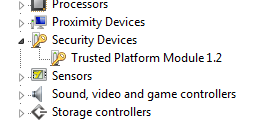
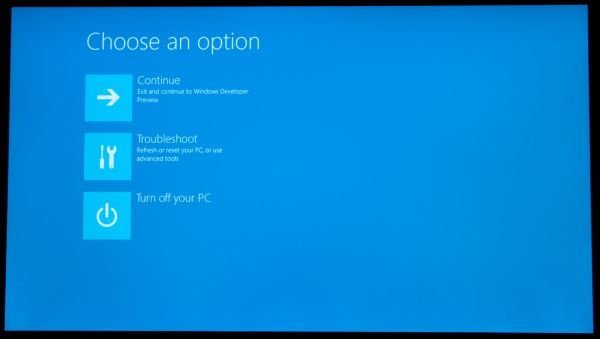
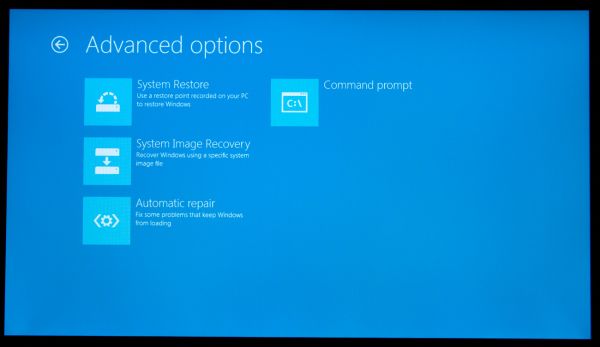
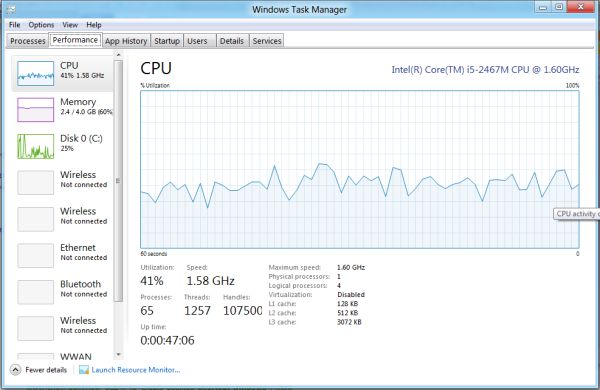
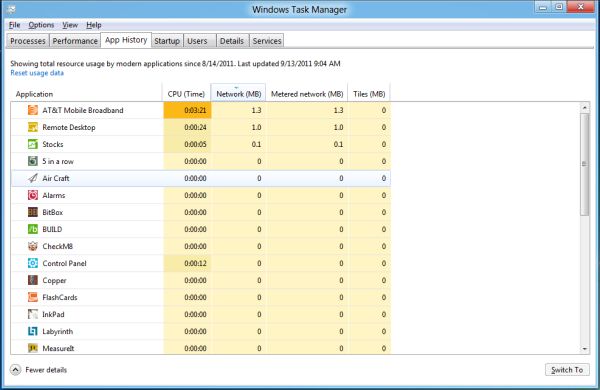








235 Comments
View All Comments
dagamer34 - Tuesday, September 13, 2011 - link
If you don't like the Metro UI, no one is forcing you to use it.jeremyshaw - Tuesday, September 13, 2011 - link
yeah, seriously. MS isn't making Metro UI for desktops, just tablets and users who want it...futurepastnow - Tuesday, September 13, 2011 - link
Yes, they are. The Explorer shell is gone and Metro has replaced it completely. In these early builds, at least, Metro cannot be turned off and you cannot boot to the desktop.dragonsqrrl - Tuesday, September 13, 2011 - link
Yes, in these early builds that may be the case, but Microsoft has stated publicly on multiple occasions that the metro UI will be optional on desktops. You can use it in combo with the traditional explorer interface (similar to the demo), or disable it entirely.UMADBRO - Tuesday, September 13, 2011 - link
He just wants to go around crying because he might have to learn something new. I think a complete redesign like this is needed. Windows was getting rather boring, even with some of the new stuff added in 7. Give it a chance at least. Im sure for all the old fogeys that have an aneurysm at the thought of anything changing, there will be some classic options. And also on note, ITS A PRE-BETA DEVELOPER RELEASE. NOTHING IS FINAL YET! SO CALM THE F&*$ DOWN!loll123 - Wednesday, September 14, 2011 - link
And you seriously think that Windows is made primarily for people like you? The corporate customers (the ones that are Microsoft's bread and butter) who resisted upgrading from Windows XP up until this day aren't going to accept change like this just because Microsoft says it's the way forward. They are going to have backtrack and redesign just like they did with Vista -> 7, unless the board of directors decide to clean up this mess and rein the design in before final release (as seems to be business as usual at Microsoft).BioTurboNick - Thursday, September 15, 2011 - link
You seem to be suggesting that 7 was a backtrack on Vista. That is far from the case.mlambert890 - Thursday, September 15, 2011 - link
+1... in addition, corporations are refreshing more and more slowly and are more and more out of sync with consumers. This is to the extreme detriment of IT as consumerization is a real trend. IT is reaching an "adapt or die" point in time and it is almost certain the latter will happen. Eventually businesses will simply allow the 'bring your own' model and contract services to provide capability.These are well known and understood industry trends and are real to anyone who *actually* works in the industry. The only folks who don't 'get it' are IT cube workers in denial or kids posting on blogs who think they understand the industry by reading comment threads.
This is actually a big problem for Microsoft because consumers are becoming a bigger force, but they are failing against Apple to capture enthusiasm with new consumers because legacy IT people, and out dated Windows users, want to keep the product stagnating.
Lost interest on the consumer side coupled with absolute inertia on the IT side is a killer for MSFT. They have to try to do something. Maybe Metro isnt it, but the nay-sayers on this thread have zero clue and are irrelevant.
The massive success of Apple has been absolute proof that consumers want a commoditized experience and the increasing presence of macbooks and ipads (guerilla style) in even *large* enterprises is proof that business is more than happy to pass the end user technology burden *onto* users.
If someone is willing to BUY and SUPPORT their OWN MacBook and ipad, why NOT let them if you are the CFO? All you need to do is ensure that your corporate apps are all presented via browser and/or managed service and enterprises are fast moving to make that happen.
It is do or die time for MSFT. if they listen to the eternal bitching and moaning of forum malcontents, they'll end up dying.
loll123 - Friday, September 16, 2011 - link
People like you say all this while Microsoft are enjoying record sales with Windows 7 (and record profits as a company as a result), and while no one can show any numbers that tablets other than those made by Apple are actually selling. In the end, although it might take the intervention of shareholders or the BoD, I think Microsoft will know better than to throw out their existing (and extremely profitable) business for what is increasingly looking like a new IT bubble.loll123 - Friday, September 16, 2011 - link
I understand your point, but a backtrack is exactly what it was. Windows 7 took all the good stuff from Vista like UAC, aggressive disk caching and the re-designed audio kernel and put them in a system with more mature drivers, important tweaks and with a smoothness and a UI that users actually liked rather than reviled. They responded to the criticisms of Vista and the result was an excellent operating system. It's no coincidence that Windows Vista failed miserably whereas Windows 7 was a huge success, but the difference was definitely in the finer details and in the user experience. Eventually Microsoft are going to have to bow to customer pressures in the case of Windows 8 as well.